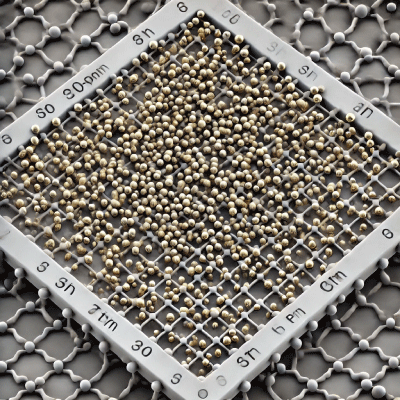TEM Grid Preparation Guide for Imaging Gold Nanoparticles
To make high-quality Transmission Electron Microscopy (TEM) grids for imaging gold nanoparticles, follow these general procedures to ensure optimal preparation:
1. Choosing the TEM Grid
-
Grid Material: Use copper or gold grids. Copper grids are common and affordable, while gold grids reduce background interference when imaging gold nanoparticles.
-
Mesh Size: Choose a mesh size between 200–400 mesh to provide good support while minimizing obstruction of the electron beam.
-
Coating Type: Use carbon-coated or formvar-coated grids. A thin carbon film is preferable for high-resolution imaging and conductivity, while formvar is often used for support.
2. Cleaning the TEM Grid
-
Plasma Cleaning: Use a plasma cleaner to remove organic contaminants and enhance hydrophilicity, making it easier for nanoparticle dispersion.
-
UV Cleaning: Alternatively, UV-ozone cleaning can also be used to ensure a cleaner surface.

Making TEM grids for gold nanoparticles imaging
3. Sample Preparation
-
Diluting the Gold Nanoparticles: Prepare a dilute solution of gold nanoparticles to avoid overcrowding on the grid.
Dilute in deionized water or a suitable solvent to ensure an even distribution.
-
Sonication: Briefly sonicate the solution to break up nanoparticle aggregates and ensure individual particles are well-dispersed.
-
The optimal concentration of gold nanoparticles (AuNPs) for TEM imaging depends on several factors, including particle size, grid type, and imaging requirements. Generally, you want a concentration that ensures even distribution without excessive overlap or aggregation. Here's guidance on selecting the right concentration:
General Guidelines:
-
Typical Concentration: A working concentration of around 0.1–1 mg/mL is often suitable for TEM imaging of gold nanoparticles.
-
Smaller particles (~5–20 nm) might require a higher concentration within this range because they are harder to detect if too sparse.
-
Larger particles (>50 nm) may need a lower concentration to avoid overcrowding.
-
- Avoid Aggregation:
- If the concentration is too high, particles may aggregate on the grid, which can obscure individual particles and lead to poor resolution.
- If too low, there may be too few particles, making it harder to capture enough images or details in a single field of view.
-
4. Grid Preparation for Sample Deposition
- Hold the cleaned TEM grid with tweezers.
- Place a small droplet (5-10 µL) of the gold nanoparticle solution on the shiny side of the grid.
- Ensure the grid is placed on a filter paper or a non-reactive surface.
- Let the solution sit for 30–60 seconds to allow the nanoparticles to adhere to the grid.
5. Blotting
- Gently blot the excess solution from the grid using filter paper or wick it away with the edge of the paper.
- Ensure you do not disturb the surface of the grid while removing excess liquid.
6. Drying the Grid
- Let the grid air-dry completely in a dust-free environment or under a fume hood. Alternatively, use a vacuum desiccator to ensure thorough drying.
- Drying time varies, but 10–30 minutes is typically sufficient.
7. Post-Deposition Treatment (Optional)
- If needed, a negative staining step can enhance contrast for better visualization of nanoparticles. However, for gold nanoparticles, this is generally unnecessary due to their inherent electron density.
8. Storage of TEM Grids
- Store the prepared TEM grids in a grid box to protect them from contamination and dust before imaging.
9. Imaging
- Insert the prepared TEM grid into the TEM for imaging. Ensure the microscope’s settings (voltage, focus) are optimized for high-resolution imaging of nanoscale objects like gold nanoparticles.
Additional Tips:
- Avoid aggregation: Ensure the concentration of gold nanoparticles is low enough to prevent aggregation but not too low that there are too few particles on the grid.
- Quality Control: Examine the grid under a light microscope or a lower magnification TEM to check for even dispersion and contamination before proceeding with high-resolution imaging.
By following these steps, you can create high-quality TEM grids that will provide excellent imaging of gold nanoparticles.
For more information and to explore their products, visit the Nanopartz™ website. Happy researching!
Go here for Nanopartz Gold Nanoparticles

